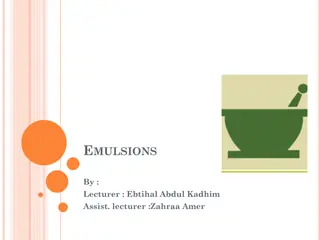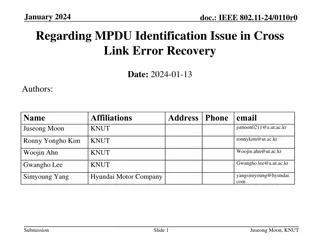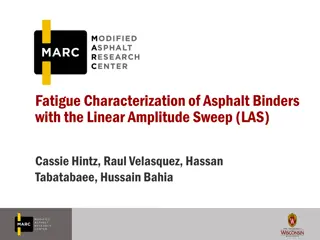Analysis of Recovery Methods for Emulsions in Asphalt Industry
This study compares the effectiveness of low temperature evaporation recovery methods in asphalt emulsions testing. The research evaluates different machines, film thicknesses, and recovery methods to understand their impact on the test results. Results show variability between labs and highlight the importance of selecting the right recovery method for consistent outcomes.
Download Presentation

Please find below an Image/Link to download the presentation.
The content on the website is provided AS IS for your information and personal use only. It may not be sold, licensed, or shared on other websites without obtaining consent from the author.If you encounter any issues during the download, it is possible that the publisher has removed the file from their server.
You are allowed to download the files provided on this website for personal or commercial use, subject to the condition that they are used lawfully. All files are the property of their respective owners.
The content on the website is provided AS IS for your information and personal use only. It may not be sold, licensed, or shared on other websites without obtaining consent from the author.
E N D
Presentation Transcript
Recovery Method Comparison Andrew Hanz & Codrin Daranga Emulsion Task Force The Center, Heritage Research Group, Indianapolis, IN June 12, 2019
Motivation Previous results presented by Asphalt Institute showed high variability between labs for many of the tests select. Evaluate the low temperature evaporation recovery method Two labs and three machines: Ergon ran on two machines, MTE on one. Three different manufacturers. Effect of nominal draw down film thickness: 20 mil vs. 30 mil. Evaluate alternate recovery methods. LTE (PP-78) vs. Vacuum Recovery (ASTM D7944)
Work Plan Factor Description Evaporation (PP-78) Vacuum (ASTM D7944) Low Temperature Recovery Method 20 mils 30 mils Film Thickness MTE Ergon CRS-2 CRS-2L CRS-2P Lab Emulsions Responses: SPG Continuous Grade, G*/sin at grade temp., phase angle at grade temp.
Results CRS-2 Continuous Grade 64 63 62 Cont. Grade ( C) 61 60 59 58 57 56 55 Ergon-1, 30 mil Ergon-1, 20 mil Ergon-2, 30 mil Lab, Film Thickness Ergon-, 20 mil MTE, 30 mil MTE, 20 mil LTE Vac Low Temperature Evap: Avg: 60.7, Std. Dev = 2.1 Vacuum Recovery: Avg: 60.4, Std. Dev = 0.8
Results CRS-2L Continuous Grade 68 67 66 65 Cont. Grade ( C) 64 63 62 61 Ergon-1, 30 mil Ergon-1, 20 mil Ergon-2, 30 mil Ergon-, 20 mil MTE, 30 mil MTE, 20 mil Lab, Film Thickness LTE Vac Low Temperature Evap: Avg: 65.1, Std. Dev = 1.25 Vacuum Recovery: Avg: 64.7, Std. Dev = 1.30 Lab Bias: MTE was higher
Results CRS-2P Continuous Grade 73 72 71 Cont. Grade ( C) 70 69 68 67 66 65 Ergon-1, 30 milErgon-1, 20 milErgon-2, 30 mil Ergon-, 20 mil MTE, 30 mil MTE, 20 mil Lab, Film Thickness LTE Vac Low Temperature Evap: Avg: 69.8, Std. Dev = 1.7 Vacuum Recovery: Avg: 69.5, Std. Dev = 0.34
Results Effect of Lab Boxplot of Cont. Grade Emulsion = CRS-2P Boxplot of Cont. Grade Emulsion = CRS-2L Boxplot of Cont. Grade Emulsion = CRS-2 67 72 72 69 69 66 Cont. Grade Cont. Grade Cont. Grade 66 66 65 63 63 64 60 60 63 Ergon-1 Ergon-2 Lab MTE Ergon-1 Ergon-2 Lab MTE Ergon-1 Ergon-2 Lab MTE
Results Effect of Recovery Method Boxplot of Cont. Grade Emulsion = CRS-2L Boxplot of Cont. Grade Emulsion = CRS-2P Boxplot of Cont. Grade Emulsion = CRS-2 72 72 72 69 69 69 Cont. Grade Cont. Grade Cont. Grade 66 66 66 63 63 63 60 60 60 LTE Vac LTE Vac LTE Vac Recovery Method Recovery Method Recovery Method
Results Effect of Film Thickness Boxplot of Cont. Grade Emulsion = CRS-2L Boxplot of Cont. Grade Emulsion = CRS-2 Boxplot of Cont. Grade Emulsion = CRS-2P 72 72 72 69 69 69 Cont. Grade Cont. Grade Cont. Grade 66 66 66 63 63 63 60 60 60 Film Thickness 20 30 20 30 Film Thickness 20 30 20 30 Film Thickness 20 30 20 30 Recovery Method LTE Vac Recovery Method LTE Vac Recovery Method LTE Vac
Observations Effect of Lab Bias was shown for one sample CRS-2L. Other samples were equivalent. Effect of Recovery Method Same result for both labs across all three emulsions. Vacuum recovery method was less sensitive to variations in procedure (i.e. film thickness) for CRS-2 and CRS-2P.
Next Steps SPG and EPG from NCHRP 9-50 has established DSR based methods for evaluating emulsion residues. Apply these concepts to developing precision and bias of recovery methods. Needs Ruggedness of individual test procedures. Single lab and multi-laboratory precision. Will be critical to NCHRP 9-63 work.























